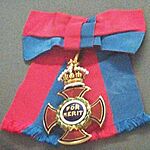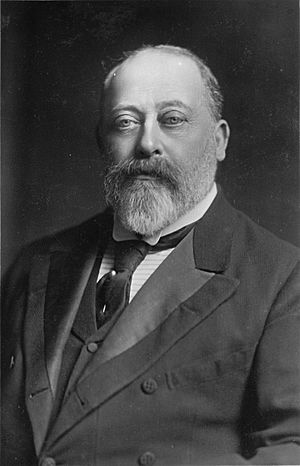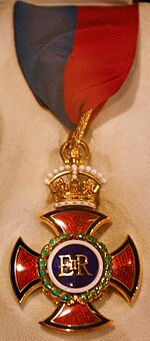Order of Merit facts for kids
Quick facts for kids Order of Merit |
|
|---|---|

Badge and ribbon bow of the order
(for wear by female recipients) |
|
| Awarded by Charles III | |
| Type | Order of merit |
| Established | 26 June 1902 |
| Motto | For Merit |
| Eligibility | All living citizens of the Commonwealth realms |
| Criteria | At the monarch's pleasure |
| Founder | Edward VII |
| Sovereign | Charles III |
| Secretary and Registrar | Robin Janvrin, Baron Janvrin |
| Grades | Member (OM) |
| Precedence | |
| Next (higher) | Dependent on state |
| Next (lower) | Dependent on state |
Ribbon bar of the order |
|
The Order of Merit is a special award given in the Commonwealth realms. It recognizes people who have done amazing things. This includes service in the armed forces, science, art, literature, or promoting culture.
King Edward VII started this award in 1902. The current King, Charles III, personally chooses who receives it. Only 24 living people from the Commonwealth realms can be members at one time. There can also be a few honorary members.
Members get to use the letters OM after their name. They also wear a special badge. The importance of the Order of Merit compared to other awards can be different in each country.
Contents
History of the Order of Merit
Early Ideas for an Award
Around 1773, King George III thought about creating a new award. He wanted to call it the "Order of Minerva". It would be for 24 great artists and writers. They would use the letters KM after their names. The award would have a special star and a sash. Its motto would be "Everything comes after science."
However, people argued too much about who should get the award. So, King George III gave up the idea. He thought about it again in 1789. This time, he wanted to include scientists too. Later, in 1805, after the Battle of Trafalgar, there was talk of a "merit" award. But nothing happened then either.
Queen Victoria's Vision
Queen Victoria and her advisors felt that the existing awards were not enough. They wanted a new award like the Pour le Mérite from Prussia. This new award would recognize achievements outside of government work. It would honor people in art, music, literature, industry, and science.
Victoria's husband, Albert, Prince Consort, was very interested. He discussed the idea of a "civil Order of Merit" in 1844. Even though they talked about it, the idea didn't become real at that time.
The Order is Created
More than 40 years later, in 1888, Prime Minister Robert Gascoyne-Cecil, 3rd Marquess of Salisbury suggested an "Order of Merit in Science and Art." It would have two parts: one for science and one for art. But the head of the Royal Academy of Arts advised against it.

It was Queen Victoria's son, Edward VII, who finally created the Order of Merit. He started it on June 26, 1902. This was the day his coronation was first planned. He wanted to honor "exceptionally meritorious service" in the military, art, literature, and science. King Edward VII set up all the modern rules for the order. This included a special group for military members.
Changes Over Time
From the beginning, prime ministers tried to suggest people for the award. But the Royal Household kept the choices secret. After 1931, many parts of the British Empire became independent countries. The Order of Merit continued to be an award for all these countries.
In 1935, the rules changed to include members of the Royal Air Force. In 1969, the rules for honorary members expanded. This meant people from other Commonwealth of Nations countries could receive it.
The order has always been open to women. Florence Nightingale was the first woman to get the award in 1907. Some famous people have turned down the award. These include Rudyard Kipling and George Bernard Shaw. Prince Philip, Duke of Edinburgh, was the youngest person to join. Queen Elizabeth II gave him the award in 1968 when he was 47.
On May 6, 2023, Robin Eames, Baron Eames, represented the order at the coronation of King Charles III.
Who Can Join the Order of Merit?
Eligibility and Selection
Anyone who is a citizen of a Commonwealth realm can be chosen for the Order of Merit. However, there can only be 24 living members at any time. This number does not include honorary members.
The King, currently Charles III, personally chooses new members. His private secretaries help him. This makes the Order of Merit one of the most respected awards in the world. There is a special military group within the order. It has its own unique badge. This group is currently empty, meaning no one is a member of it right now.
Honorary Members
Honorary members are another group. There is no limit to how many there can be. But these awards are very rare. People from Commonwealth countries not led by King Charles are considered foreigners. They can receive honorary awards. Examples include Nelson Mandela from South Africa and Mother Teresa from India.
When someone joins the Order of Merit, they can use the letters OM after their name. They also receive the special badge of the order.
The Order's Insignia
The Order of Merit has a special badge. It is a golden crown with a red cross hanging from it. In the middle of the cross is a blue circle. This circle is surrounded by a laurel wreath.
On the front of the blue circle, it says FOR MERIT in gold letters. On the back, it has the King's special symbol in gold. The badge for military members has two crossed swords behind the blue circle.
The ribbon for the Order of Merit is red and blue. Men wear their badges on a ribbon around their neck. Women wear theirs on a ribbon bow pinned to their left shoulder.
Since 1991, the badge must be returned when a member passes away.
Current Members
Sovereign
| Name | Year of appointment | Present age |
|---|---|---|
| King Charles III (ex officio) | 2002 as The Prince of Wales; sovereign since 2022 | 77 |
Substantive members
| Member
number |
Name | Known for | Year of appointment | Present age |
|---|---|---|---|---|
| 1 (169) | Norman Foster, Baron Foster of Thames Bank OM, RA, | Famous architect | 1997 | 90 |
| 2 (175) | Sir Roger Penrose OM, FRS, HonFInstP | Mathematical physicist and Nobel Prize winner | 2000 | 94 |
| 3 (176) | Sir Tom Stoppard OM, CBE, FRSL, | Playwright | 88 | |
| 4 (180) | Sir David Attenborough OM, GCMG, CH, CVO, CBE, FRS, FSA, FRSA, FLS, FZS, FRSGS, FRSB, HonFLI | TV presenter and conservationist | 2005 | 99 |
| 5 (183) | Robin Eames, Baron Eames OM | Former Archbishop | 2007 | 88 |
| 6 (184) | Sir Tim Berners-Lee OM, KBE, FRS, FREng, FRSA, FBCS | Inventor of the World Wide Web | 70 | |
| 7 (185) | Martin Rees, Baron Rees of Ludlow OM, FRS, FREng, FMedSci, FRAS, HonFInstP | Astronomer Royal | 83 | |
| 8 (186) | Jean Chrétien PC, OM, CC, KC, | Former Prime Minister of Canada | 2009 | 91 |
| 9 (187) | Neil MacGregor OM, AO, FSA | Art historian and museum director | 2010 | 79 |
| 10 (188) | David Hockney OM, CH, RA | Artist | 2012 | 88 |
| 11 (189) | John Howard OM, AC, SSI | Former Prime Minister of Australia | 86 | |
| 12 (190) | Sir Simon Rattle OM, CBE | Conductor | 2014 | 70 |
| 13 (192) | Sir Magdi Yacoub OM, FRS | Heart surgeon | 90 | |
| 14 (193) | Ara Darzi, Baron Darzi of Denham OM, KBE, PC, FRS, FMedSci, FRCSI, FRCS, FRCSE, FRCPGlas, FACS, FRCP, FREng | Surgeon | 2016 | 65 |
| 15 (194) | Dame Ann Dowling OM, DBE, FRS, FREng | Mechanical engineer | 73 | |
| 16 (195) | Sir James Dyson OM, CBE, RDI, FRS, FREng, FCSD, FIEE | Inventor and designer | 78 | |
| 17 (196) | Dame Elizabeth Anionwu OM, DBE, FRCN | Nurse | 2022 | 78 |
| 18 (197) | Floella Benjamin, Baroness Benjamin OM, DBE, DL | Broadcaster | 76 | |
| 19 (198) | Margaret MacMillan OM, CC, CH, FRSL, FRSC, FBA, FRCGS | Author and university leader | 81 | |
| 20 (199) | Sir David Adjaye OM, OBE, RA | Architect | 59 | |
| 21 (200) | Sir Paul Nurse OM, CH, FRS, FMedSci, , , MAE | Geneticist and Nobel Prize winner | 76 | |
| 22 (201) | Venki Ramakrishnan | Biologist and Nobel Prize winner | 73 | |
| 23 | Vacant | |||
| 24 | Vacant |
Honorary members
There have been no honorary members of the Order of Merit since Nelson Mandela passed away in December 2013.
Officers
Secretary and Registrar: Robin Janvrin, Baron Janvrin GCB, GCVO, QSO, PC
Order of Wear
The Order of Merit is open to citizens of 15 different countries. Each country has its own system for awards. So, the Order of Merit's place in the list of awards changes from country to country.
In the United Kingdom, the letters OM come after other high awards. However, being a member of the Order of Merit itself does not give you a special rank in the UK's social order. Still, many experts say the Order of Merit is the highest honor in the British awards system.
Here are some examples of where the Order of Merit ranks:
| Country | Preceding | Following |
|---|---|---|
Order of wear |
Knight/Lady of the Most Ancient and Most Noble Order of the Thistle (KT/LT) | Knight/Dame of the Order of Australia (AK/AD) |
Order of wear |
Cross of Valour (CV) | Companion of the Order of Canada (CC) |
Order of wear |
Knight/Dame Grand Cross of the Most Honourable Order of the Bath (GCB) | Member of the Order of New Zealand (ONZ) |
Order of wear |
Knight/Dame Grand Cross of the Most Honourable Order of the Bath (GCB) | Baronet's Badge (Bt) |
See also
 In Spanish: Orden del Mérito del Reino Unido para niños
In Spanish: Orden del Mérito del Reino Unido para niños


